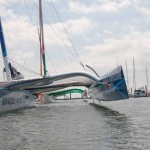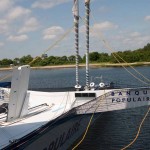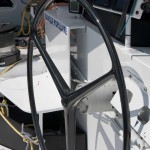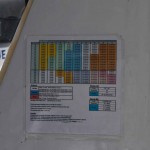
As we pull up to the Gateway Marina in Brooklyn, New York, in the distance to our right is the New York City skyline. To our left are 3 large masts towering over all the other boats in sight. These three giants are The Maxi-Trimarans Banque Populaire V skippered by Pascal Bidégorry (40m/131.2 ft) and Groupama 3 skippered by Franck Cammas (105ft) and Sodebo solo-skippered by Thomas Coville (105ft). All three are laying in wait for the weather window to set out to break the North Atlantic record. This record is a 2,980 mile run from Ambrose Light (Off the coast of New York) to Lizard Point (South-West tip of England). It is not often in the USA that we get to see such an impressive line up of Multi-hulls on one dock. They looked like thoroughbreds patiently waiting to be called into action.
We were graciously given the complete tour of Banque Populaire V, which is also the largest racing Trimaran in the world, by a member of the shore crew Philibert Chenais. As I sat in the cockpit I got a much better understanding of the workings of the boat. The sheer scale of the size of the boat becomes apparent from the cockpit. It is a long way forward and aft. The mast towers above at 47 meters/154.2ft. At this height it is taller than the Arc de Triomphe in Paris. The boat is 23.5 meters/77 ft wide. She has been lightened as much as possible and all systems have been checked and rechecked. The freeze dry food is stowed. They have no motor now except the small 27 horse needed to power the electronics and navigation gear and to keep the hydraulic systems, of which there are many, running. This is a beautiful, sleek, shiny, well maintained monster of boat.

Banque Populaire V will carry 7 sails for this record attempt. A Cuben Fiber Main that alone and takes 8 men approximately 9 minutes to raise using the various winches and grinders positioned around the cockpit. This Main will be used on the boat for this record and also in the subsequent Jules Verne Trophy attempt next winter. Three downwind sails. A masthead and a fractional sail and a staysail. All necessary but as few as possible to keep the weight onboard down.
The 47 meters of mast is a hydraulic canting mast designed to be set to any degree necessary to keep the boat’s sail angle verticle as the boat heels. This is so that the limited apparent wind range on the maxi will not affect the sail trim. It sails so fast that the apparent wind range is reduced. The mast cants using large rams in a carbon fiber mounting down deep inside the hull. It has an 80 degree range side to side. The forward stay is attached to another hydraulic system which is used to tighten the luff so the foward sail can be kept flat. The flatter the better with this sail plan.
Images by George Bekris
(click on image to enlarge)
The Harken winches are designed to gear down to help the crew manage the large loads on the sheets. The grinding pedestals and winches have 4 speeds. At the pull of a cord they can gear down quickly. This boat gears down to trim the jib unlike Volvo 70s, which gear up. It can take up to 8 men on the winches to trim in heavy air.
For the record attempt she will have the skipper Pascal Bidégorry and a crew of 11. The fact that this is a short run, 3-4 days for the record, sleep onboard will be more optional. The record now stands at 4 days 3 hours 57 minutes and 53 seconds . Philibert explained that for a record run of this type more crew up top on deck at any given time helps because they can quickly respond to any sail changes needed for optimum speed. Just shaving seconds off shaking out a reef or trimming the sail could mean the difference between breaking the record and not breaking it. These days the records are that tight. Every fraction of a knot means alot. During the Jules Verne Trophy run next winter they will run a more regular sleep schedule with a 5 on 5 off at any given time plus the skipper.

Icebergs and whales have been a concern for the skippers on this North Atlantic run. While Banque Populaire V was crossing the Atlantic on her delivery run to New York they did hit a whale. Luckily the the daggerboard was sacrificial and designed to break off before the boat itself can be damaged. The boat can loose one and be fine as it is designed with three. The late summer attempt should minimize the risk of late season icebergs so that should not be a problem now.
Banque Populaire V will be taken out of the water this fall in France and refitted. After the refit she will be setting out to break the Jules Verne Record in the winter of 2010.








































































